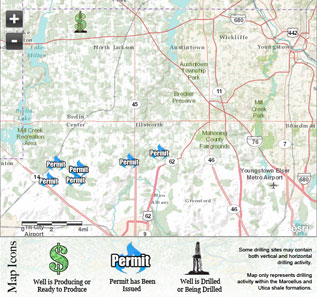Useful Links
Documents
- Injection Well AWMS Orders
- KDA Affidavit
- US vs. Ben Lupo - Indictment
- US vs. Ben Lupo - Criminal Complaint
- Final Analytical Report for Ohio EPA-NEDO
- D&L Sample Results Statement
- OhioEPA IPIR
- OhioEPA Notice of Violation
- Patriot vs. Ohio EPA Decision
- EPA Response - Patriot Water
- Patriot vs. Ohio EPA Motion to Dismiss
- ALOV Trumbull Group Lease

« Shale Sheet Home
Game of chicken over oil costs jobs, benefits consumers
By KALEA HALL
khall@vindy.com
YOUNGSTOWN
PNC Bank Economist Mekael Teshome remembers when there was a concern that the price of oil would go up to $200 a barrel back in 2008.
“It feels surreal,” he said.
That’s because last week, the price per barrel hit below $30 and is expected to go lower. One analyst says oil could plunge as low as $10 to $20 a barrel.
“I think that is still a valid prediction,” said A. Gary Shilling, president of A. Gary Shilling & Co., a New Jersey financial consultant.
Shilling initially estimated a price drop to $10 to $20 last February, which spurred other analysts to argue that was unlikely.
The recent price drop below $30 has the $10-to-$20 prediction look like more of a possibility.
“I am entirely surprised,” Teshome
said. “I wasn’t expecting it to go [this] low.”
The consumer is the largest beneficiary of the low energy prices. On average, the American motorist saved more than $700 last year from lower gas prices, according to AAA. But a low price of $10 to $20 a barrel would cause a greater impact than low costs at the pump. Bankruptcies would occur and financial markets would respond negatively, analysts say.
Energy companies wouldn’t be able to sustain themselves at that price for that long. And banks and other financial institutions have made substantial investments into energy companies.
That fuels fear of another 2008-like economic collapse. Consider how the 2008 housing crash impacted the entire economy.
“That will reciprocate a recession on a global basis,” Shilling said. “Sure, everyone wants cheaper oil and cheaper natural gas. People should think beyond the heating bills and pumping the gas.”
In a game of chicken, the goal is to force an opponent to be the first to swerve to avoid a head-on collision.
In this game, OPEC did not yield to the cartel members who wanted more profits and market share. OPEC’s leader, Saudi Arabia, would typically have cut production to prevent a price collapse.
But so far in this game, the Saudis have not swerved.
“The Saudis had [cut back on production] for decades, and as a result, OPEC production over the last 10 years has been flat, with all the growth instead enjoyed by non-OPEC producers, including U.S. frackers and Canadian oil-sands companies,” Shilling wrote in an August Bloomberg News column. “The Saudis got tired of seeing their market share shift to others, so they and the other financially strong Persian Gulf producers decided to play a high-level game of chicken.”
It’s a costly game.
The world uses two primary oil benchmarks: Brent and West Texas Intermediate. Brent is the most widely used marker because about two-thirds of all crude contracts in the world reference Brent Blend. This blend comes from fields in the North Sea, according to Investopedia. The oil there is sweet, light and ideal for diesel fuel, gasoline and other products.
West Texas Intermediate oil refers to oil extracted from U.S. wells. It is a light, sweet product that is also ideal for gasoline refining, according to Investopedia.
The price of crude oil started to fall after June 2014 when it was $107 per barrel. The price for a barrel of West Texas Intermediate crude oil hit as low as $54 in December 2014. In 2015, the price did climb some from March’s report of $43 a barrel up to $60 in May, but that price didn’t stay there for long.
In April 2015, PNC forecast that the price would be up to $60 per barrel by fourth quarter of 2015.
The year closed with prices in the mid-$30 range.
For the week of Jan. 11-15, the price of WTI crude oil was $30.44, according to the U.S. Energy Information Administration. Earlier last week, the price of crude dropped below $30 a barrel for the first time since December 2003 when it touched $29.93.
Friday’s price drop to $29.67 for WTI crude and $29.14 for Brent, according to Bloomberg Business, drove world stocks down. Reuters reported major stock indices in Europe and Wall Street dropped more than 2 percent.
The Dow Jones industrial average fell 390 points, or 2.4 percent, to close at 15,988 on Friday. The Standard & Poor’s 500 index fell 44 points, or 2.3 percent, to 1,876. The Nasdaq fell 126 points, or 2.7 percent, to 4,488.
The Dow and the S&P 500 are both down 8.2 percent since Jan. 1. The Nasdaq is down 10.4 percent.
WHEN DOES IT END?
The question pondered by producers and suppliers alike is: When does this game end, and when will the prices rebound?
Analysts say the rebound will not be this year. It will come when the base price is hit, and a major player in the game swerves.
But the chance of oil getting back to $100 a barrel anytime soon is unlikely.
“There’s just too much oil in the world,” Shilling said. “You have got a lot of production out there that will limit the prices long term.”
The U.S. Energy Information Administration expects to see prices of Brent crude oil to average $40 per barrel in 2016 and $50 per barrel in 2017. West Intermediate Crude oil will be $2 lower than Brent in 2016 and $3 lower than Brent in 2017, according to the EIA’s forecast from Wednesday.
The EIA expects the WTI price to average $37 per barrel in April 2016. Oil prices are expected to remain low during the year as supply will continue to outpace demand.
Inventories are forecast to rise by an additional 0.7 million barrels a day in 2016, before the global oil market balances out in 2017.
In PNC Bank’s December 2015/January 2016 Economic Outlook reporter, economists estimated the price of WTI crude oil would hit $46 a barrel by the fourth quarter of 2016. Since the report was released, PNC economists have lowered their forecast for the fourth quarter of 2016 to $37.
“The story hasn’t changed,” Teshome said. “What has changed is the magnitude and the duration we have talked about.”
Teshome expects the price to remain low the rest of this year with Iran expected to add even more supply to the already saturated market. Prices at $10 a barrel are not impossible, Teshome said.
“I think it is too low,” he said. “There are too many producers that would be hit. Any further below $20, and I don’t know how many producers would make a profit.”
George Mokrzan, director of economics for Huntington Bank, doesn’t have a set expectation for the price of oil this year.
“It is very challenging to do because there are so many variables,” he said. “Ten dollars a barrel would be a possibility if the world went into a deep recession. I don’t think it will happen.”
THE REALITY
Consumers pumping gas at $1.69 in Youngstown on Friday may not have realized what cheap gas means to the energy industry.
Low prices can cost the economy energy jobs.
“I don’t think it is any secret that it is definitely a difficult time in the oil and gas industry,” said Shawn Bennett, executive director of the Ohio Oil and Gas Association.
The U.S. rig count in the U.S. is 664, down from 1,086 from last January, according to Baker Hughes, an oil-field service company that keeps an ongoing update of the rig counts. In Ohio, the rig count was at 14 during the second week of January compared with 51 during the second week of January 2015.
Bennett believes the story of 2015 will continue this year: more cuts in drilling and fewer wells drilled in the nation and the state.
“I think we are waiting and hoping for a bottom, but that bottom hasn’t been reached yet,” Bennett said. “How low we will go is anyone’s guess.”
Locally, the Mahoning Valley has watched Vallourec Star, a pipe-producing plant for the fracking industry on Martin Luther King Jr. Boulevard, continue to cut back. So far, 180 jobs have been cut at the local plant.
Exterran, a Salt Springs Road plant where compressors are made for the oil and gas industry, announced an indefinite closure will begin in March. The company has already let some of its 70 workers go.
Parker Hannifin announced in October it will close its Youngstown operation with 137 employees where hydraulic gear pumps for various industries including oil and gas are manufactured.
In total, the downturn in the industry has cost the area more than 380 jobs — so far.
SOME GOOD NEWS
But while those in the energy industry are hurting, others are thriving. Take the auto industry. In 2015, vehicle sales broke the previous record set in 2000. This year, 18 million sales are expected, which would break the 2015 record of 17.5 million.
“We are going through some changes but it doesn’t necessarily mean that the long-term future is bad,” Mokrzan said. “I think the economy [here] is diversified enough to manage it. Overall, the region has done quite well with the changes. We have the autos to counter balance the energy industry.”
















Subscribe Today
Sign up for our email newsletter to receive daily news.
Want more? Click here to subscribe to either the Print or Digital Editions.